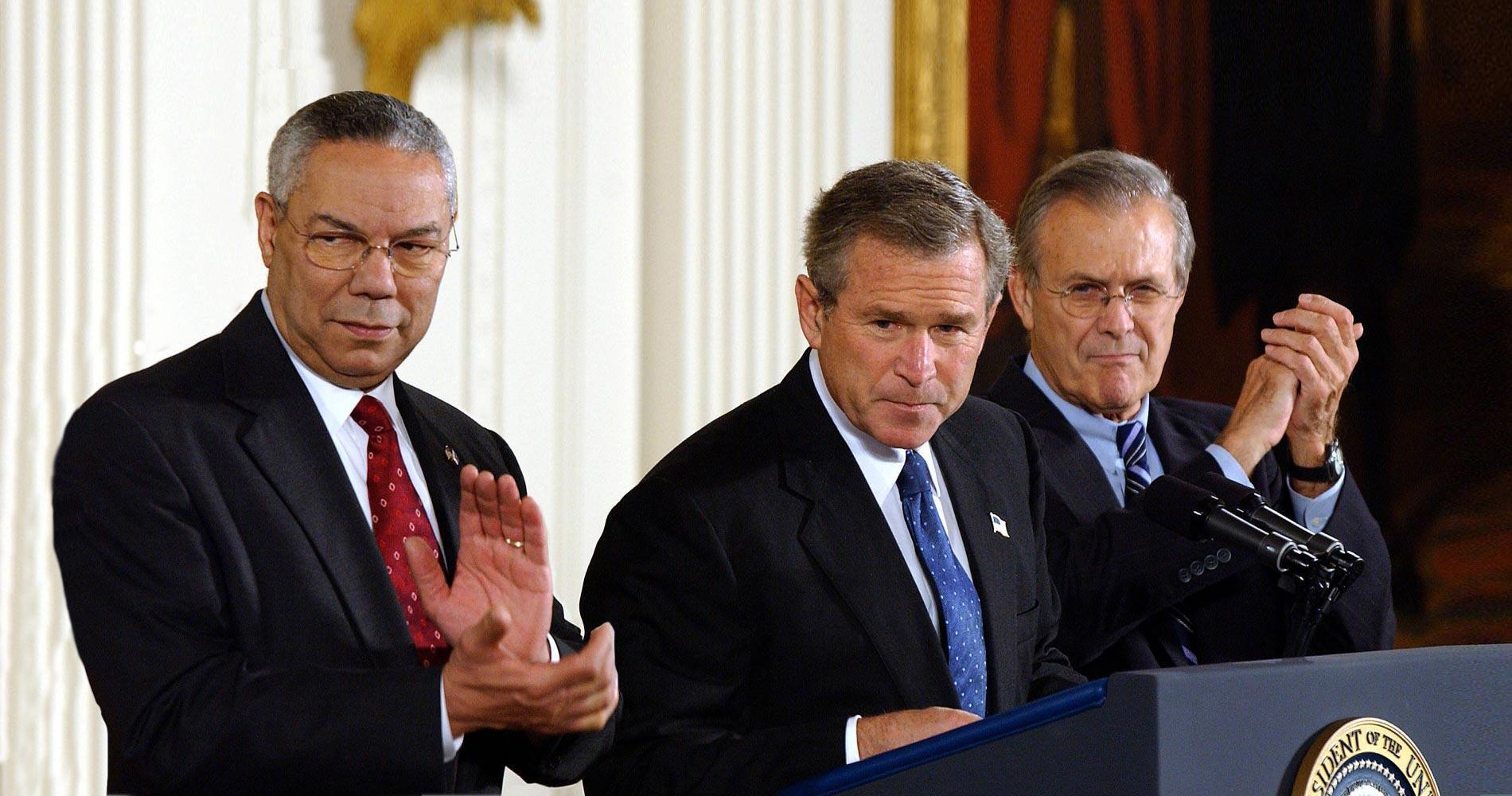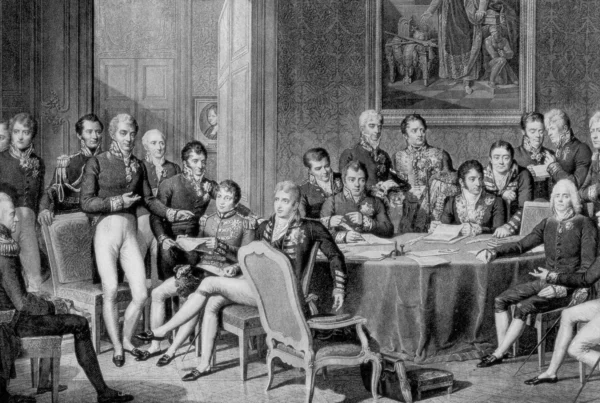The US invaded Iraq 20 years ago with the aim of overthrowing Saddam Hussein, freeing its people and disarming Iraq to ‘defend the world from grave danger’ including assumed but never found Iraqi weapons of mass destruction. The invasion followed 13 years of UNSC sanctions. Iraq was destroyed and hundreds of thousands died. Thousands of US landmines were left behind. The US military has not left Iraq despite an Iraqi parliamentary vote demanding they leave. US oil and strategic interests in the ‘Greater Middle East’ cannot afford to give up this valuable base.
Diana Mautner Markhof, 20 March 2023
On 20 March 2003 US President George W. Bush ordered the invasion of Iraq. The aim of “Operation Iraqi Freedom”- the invasion of Iraq by a US-led multinational military coalition – was to overthrow Saddam Hussein, free its people and disarm Iraq to ‘defend the world from grave danger’ including assumed but never found Iraqi weapons of mass destruction (WMD). The invasion followed thirteen years of US-led UNSC sanctions on Iraq, from 1990 to 2003, which threw Iraq, a developed and secular Arab state, back to a pre-industrial level.
According to Brown University’s Cost of War Project, the US wars in Iraq and Syria cost the US taxpayer USD 2.9 trillion and directly killed 300 000 Iraqis, with many more dying from the lasting impact of the war and the destruction of critical infrastructure.
In May 1996, Lesley Stahl of CBS asked the then US Secretary of State Madeleine Albright to comment on the ongoing humanitarian catastrophe in Iraq: “We have heard that a half million children have died. I mean, that’s more children than died in Hiroshima. And, you know, is the price worth it?” Madeleine Albright’s reply: “I think this is a very hard choice, but the price – we think the price is worth it.”
A 1991 UN report came to the conclusion that the First Gulf War (aka Operation Desert Storm) from 17 January 1991 to 28 February 1991 had “near-apocalyptic results” on Iraq’s economic infrastructure. Bombs destroyed the electrical systems to only 4% of pre-war levels. Oil refineries, food storage facilities, sewage treatment plants, industrial infrastructure, telecommunications facilities, roads, trains and bridges were all heavily and deliberately damaged or destroyed during the war. Declassified documents of the US Defense Intelligence Agency show the deliberate targeting of power plants, water storage facilities and waste treatment plants.
Noam Chomsky called the US attacks on sewage treatment plants, irrigation systems, and water purification plants “acts of biological warfare”.
The ‘chemical’ warfare waged by the US’ use of depleted uranium munitions left Iraq with a humanitarian and environmental disaster whose repercussions on Iraqi health, agriculture and water supply are still being felt. The contaminated groundwater continues to kill innocent Iraqi civilians and poison the livestock. The bombs dropped by the US on Iraq set half of Iraq’s oil fields on fire, releasing deadly toxins into the environment. After Operation Iraqi Freedom, Iraq was left with thousands of US landmines, which are still all over Iraq.
The cumulative effects of the destruction of war and the ongoing sanctions and embargo restrictions accelerated the famine and epidemics in Iraq after 1991.
What the First Gulf War did not destroy, the UNSC imposed sanctions did. These sanctions, which lasted 12 years and 8 months, were one of the UN’s greatest failures. The UNSC became hostage to US foreign policy. Following the US lead these sanctions placed Iraq under the control of the UN and its grossly mismanaged Oil-for-Food-Program. Hundreds of thousands of Iraqis, both civilians and combatants, died as a result of the sanctions. An entire nation was intentionally made to pay for Saddam Hussein’s wrongdoings. Iraq’s cities were destroyed, its population starved and its industry and economy demolished. According to the WHO, Iraq’s health system was thrown back 50 years.
Prior to the First Gulf War, Iraq was not a developing third-world nation, but a highly developed country with a large educated middle class, excellent health care, a solidly developed infrastructure and industrial base and a strong currency. Iraq’s oil revenue accounted for up to 95% of Iraq’s economy. Iraq was a founding member of OPEC with 10% of the world’s oil reserves. In addition to oil, Iraq’s natural resources include natural gas, phosphates, and sulfur. In 1980 Iraq’s per capita income was considered to be 60% of the OECD average. This would fall to less than 4% of the OECD average by 1993.
By 2003 over 50% of Iraqi families lived below the poverty line. This steep decline in the household economy of average Iraqi families affected national educational levels. Many children dropped out of school, having to earn extra money for their families. According to a 2000 UNICEF report, 23% of Iraqi children were not attending primary school by 2000 and were forced to beg, for lack of other possibilities to make any money.
Malnutrition, famine, death and disease followed the war and sanctions. Infectious diseases such as cholera, typhoid, gastroenteritis, malaria, meningitis and measles appeared or re-appeared. According to the FAO, by January 1998 there were more than 50 000 documented cases of screwworm infestations in Iraq. Screwworms infest livestock and also lay eggs in humans. Especially children in rural areas were affected, because of the low hygienic conditions.
Iraq, once an ally of the US during the Iran-Iraq war, became enemy number one when it invaded Kuwait in 1990. The US-led First Gulf War and sanctions against Iraq were primarily determined by the US neoconservative foreign policy objectives in the Middle East: regime change became the foreign policy objective of every US administration and the unlawful and undeclared goal of the UNSC sanctions
The neoconservative discourse at the time in the US sought to define and determine the ‘new world order’ after the fall of the Soviet Union. Their new world order consisted of: exporting democracy by force if necessary, including regime change; liberal economics including the “free market”; globalization; freedom of capital movement; free trade; minimum regulation; and dominating international agencies and financial organizations.
The neoconservatives wanted to change the governments of the ‘Greater Middle East’ to assure, at a minimum, their conformance with US policy and strategic aims. Iraq, Iran, Syria and Libya were thus prime candidates for regime change, which would also give the US access to the vast oil reserves of these countries. Those countries who were not in this ‘club’ were the ‘other’ and this came with a cost – the exclusion from the global economy and financial system as well as from the “international community”. This is a pattern which the US and its allies have continued to follow.
By 2002 at the latest, the US was preparing for war in Iraq to remove Iraq’s non-existent WMD. Colin Powell, in his now infamous speech before the UNSC on 5 February 2003, also based his ‘knowledge’ of WMD on so-called intelligence gathered through piggyback intelligence operations and Iraqi dissidents. On 17 March 2002, Vice-President Cheney stated: “we believe he [Saddam] has … nuclear weapons.” A claim as fake as Powell’s. On 17 May 2016, Powell called his speech a “blot” on his record, admitting that Iraq did not have WMD in 2003.
The suffering resulting from UNSC sanctions did not lead to the overthrow of Saddam Hussein. Operation Iraqi Freedom in 2003 finally removed Saddam Hussein and ensured US access to Iraq’s large oil reserves. Saddam Hussein, the deposed president of Iraq, was captured by the US in the town of Ad-Dawr, Iraq on 13 December 2003. President Bush proudly proclaimed “the capture of this man was crucial to the rise of a free Iraq.” Hussein was executed on 30 December 2006.
The number of violent deaths resulting from the 2003 war range from a couple of hundred thousand to over one million Iraqis. This death toll is in addition to the 1.5 million estimated to have died as a result of the UNSC sanctions regime, including 500 000 child deaths.
The 20th anniversary of the US invasion of Iraq is a reminder of the limits and weaknesses of the UN system and how great power politics and oil interests trump humanitarian considerations. Iraq today remains politically and economically unstable and is still struggling with the devastation caused by the US attacks and by the US-led UNSC sanctions regime.
The law which enabled President George W. Bush to invade Iraq, the 2002 Authorization for Use of Military Force Against Iraq (AUMF), has not been repealed. Momentum is growing among Republicans and Democrats to put the power to declare war back where it belongs – in Congress. The 2002 Iraq AUMF still enables the President of the United States to use the US armed forces whenever “necessary and appropriate” to defend against any threat posed by Iraq. Even after the Iraq war ended in 2011, the 2002 Iraq AUMF was used by subsequent Presidents Obama and Trump to justify the continued use of force in Iraq and Syria.
On 5 January 2020 Iraq’s parliament voted to expel all American troops from the country. Prime Minister Adil Abdul Mahdi stated “Iraqi priorities and the US are increasingly at odds”. However, US interests in the ‘Greater Middle East’ cannot afford to give up this valuable base. Even today 2500 US troops remain in Iraq, with no plans to leave anytime soon.
On the occasion of the 20th anniversary of the US invasion and destruction of Iraq, the experience familiar to many countries in Europe and Asia repeats itself yet again—once the US enters a country militarily, they never leave.
Picture: 06 November 2003 President George W. Bush (center, U.S.) with Secretary of State Colin Powell (left, U.S.) and Defense Secretary Donald Rumsfeld (right, U.S.) during a press briefing on an Iraq reconstruction bill in Washington, D.C. ©IMAGO / UPI Photo
Other Articles Which Might Interest You
Interview With Professor Catherine Lutz Of Brown University’s Cost Of War Project: A Strong Voice For Democracy







